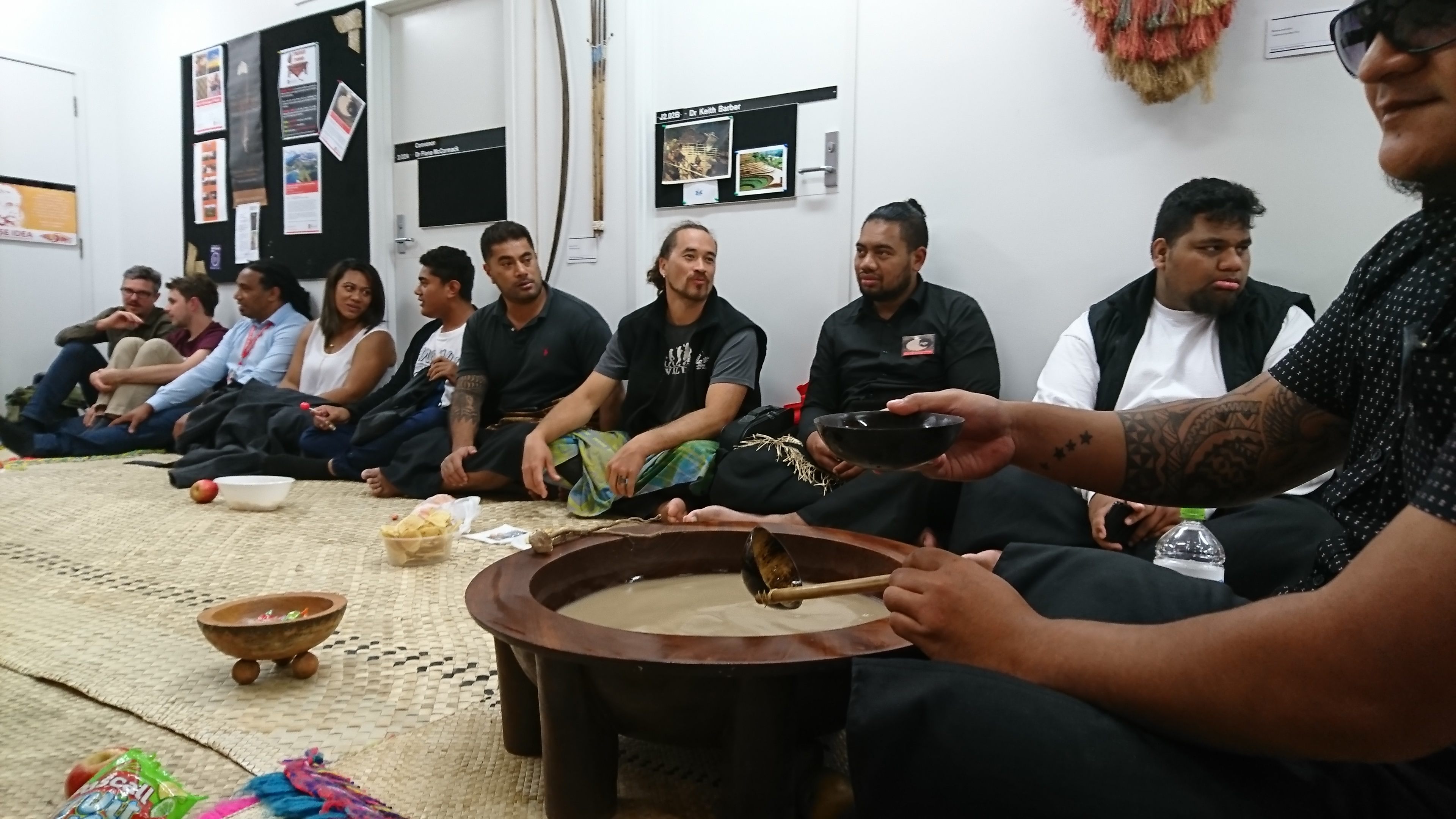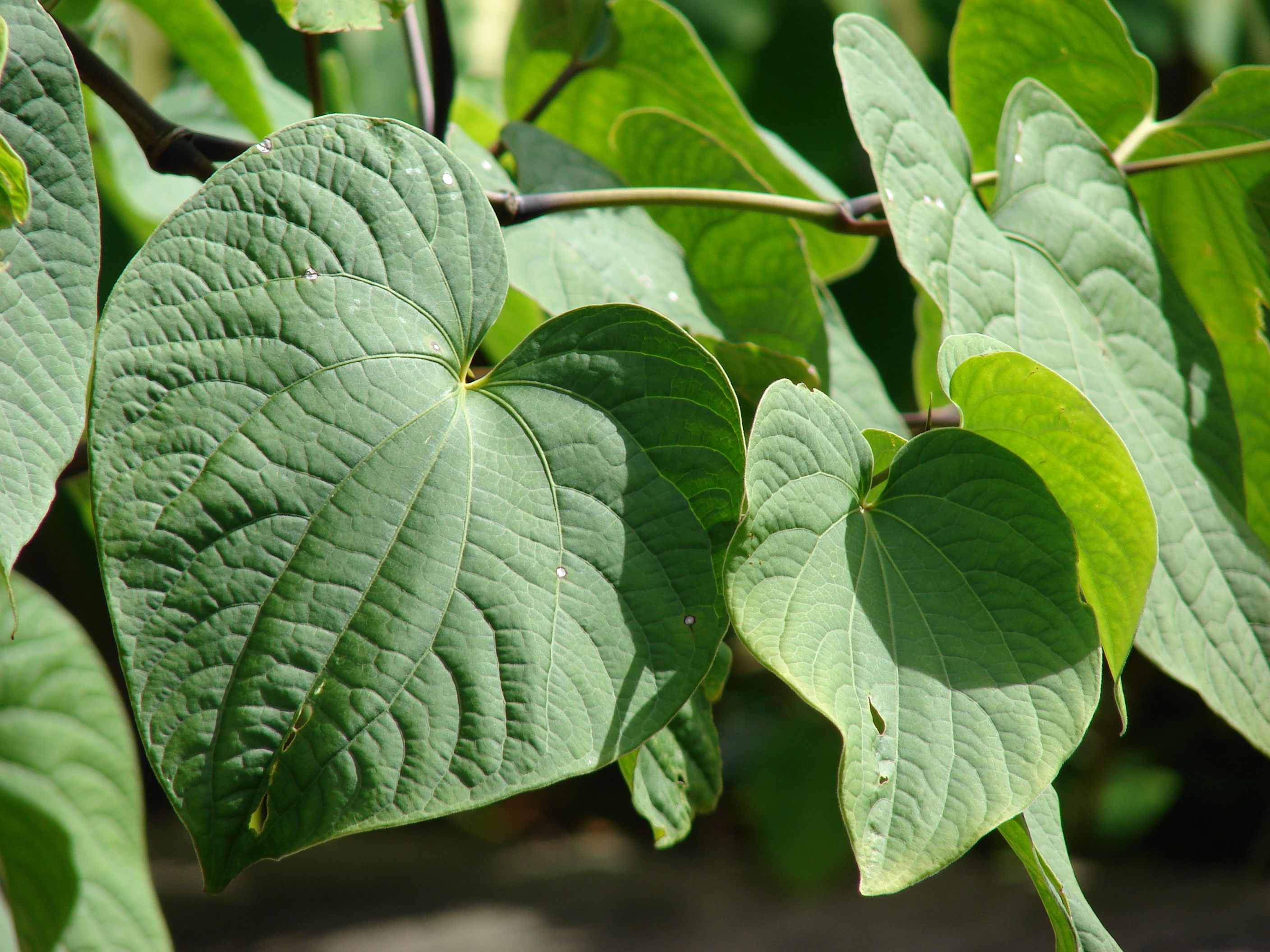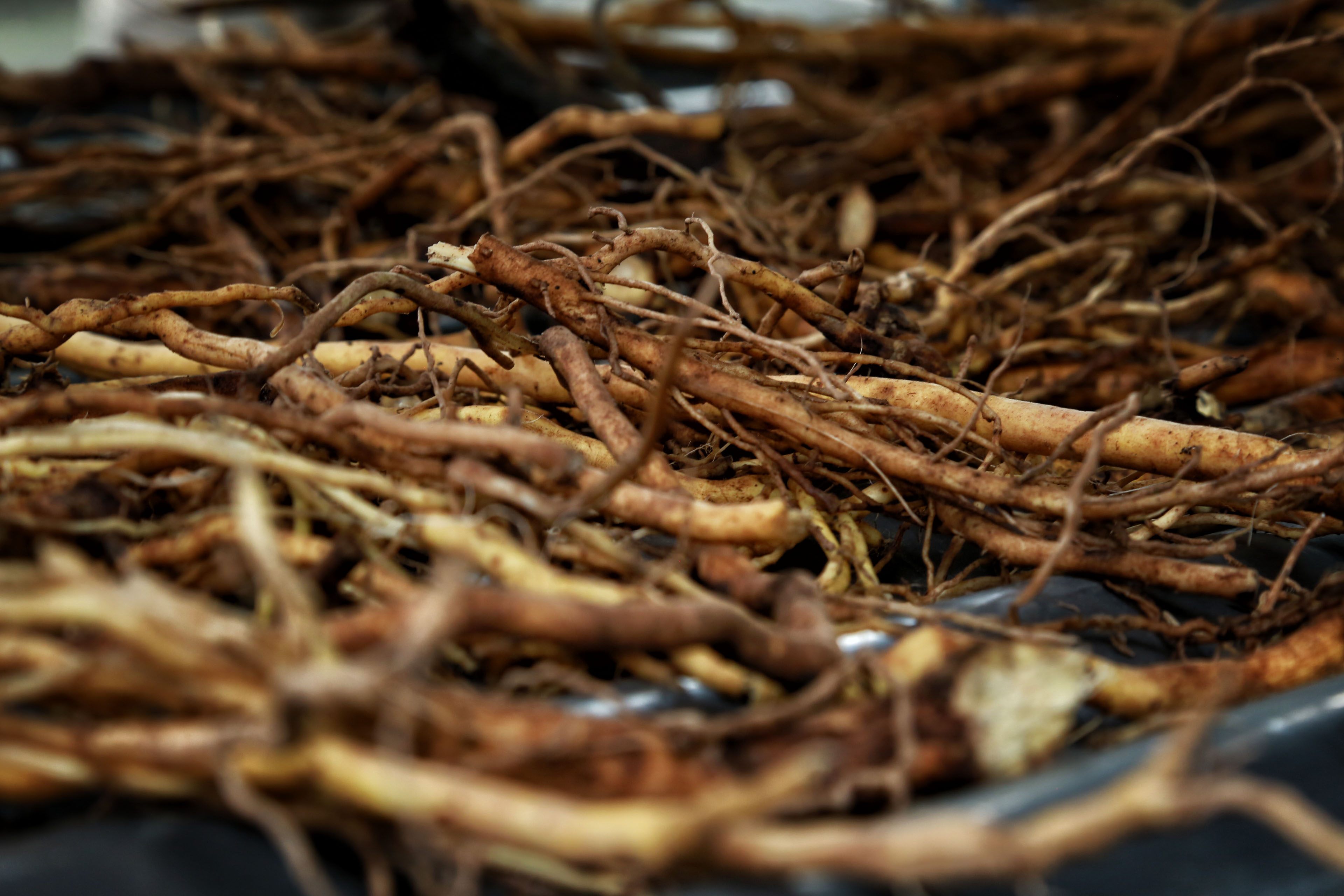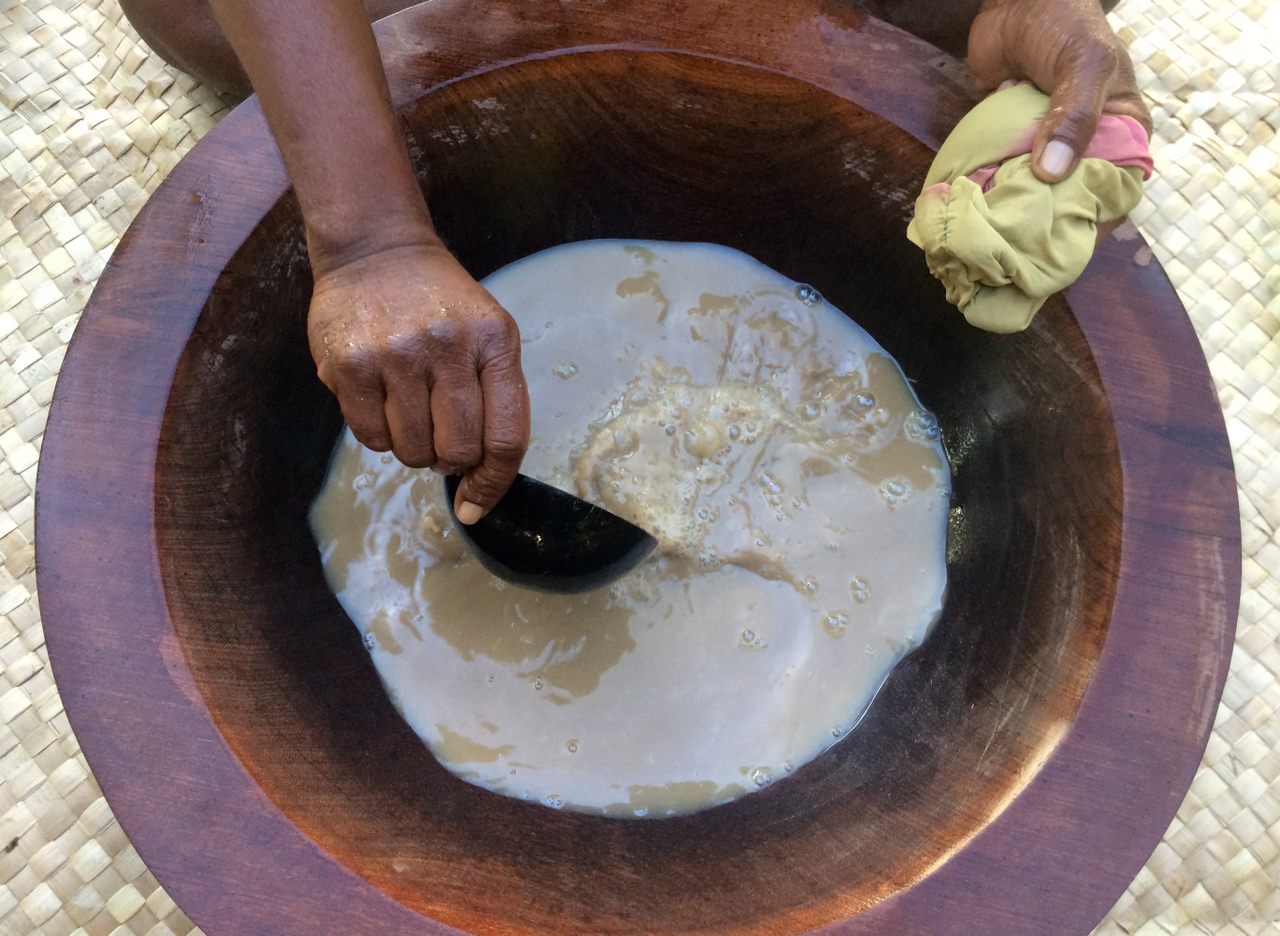Why Kava Laws Choose Tradition Over Commercialization
New Zealand regulations prevent the sacred beverage of the Pacific Islands from being watered down.
At Four Shells Kava Lounge in Auckland, New Zealand, Todd and ‘Anau Mesui-Henry prepare kava in the traditional manner. The dried, powdered root of the kava plant is placed in a mesh bag, soaked in water, and squeezed to produce an opaque, brownish beverage, which is often drunk from a coconut shell. Todd explains that this unadulterated presentation is a major part of kava’s long history. In the thousands of years that Pacific Islanders have been drinking kava, he says, “not a single island has formed a culture around flavoring the kava, or mixing it with anything to mask the flavor.”
Kava’s earthy, bitter flavor can be polarizing. “People don’t drink it for the taste,” Todd says. “Although most people who get into it, once you feel the effects of the taste, nobody cares about it anymore.” It is the physical effects of drinking kava, thanks to unique compounds called kavalactones, that have made it not just popular but sacred for Pacific Islanders. The first few sips of kava can make your mouth and throat feel numb. After that, a full-body feeling of deep relaxation and calm sinks in. Studies suggest that kava’s soothing qualities may be effective in treating anxiety and PTSD. Because kava is not physically addictive, carries low health risks, and does not impair judgment, it’s also been widely touted as an alternative to alcohol.
But outside places where kava is traditional, its flavor is commonly cited as a feature that limits its appeal, and its commercial potential. “The future of kava lies in making it delicious,” claims the website of a U.S.-based kava company called Psychedelic Water, which sells kava beverages with flavors like hibiscus-lime and orange-vanilla. To consume kava the traditional way, Psychedelic Water’s website laments, is “just no fun.”
The Mesui-Henrys do not serve flavored kava at Four Shells, but this is not only due to preference and tradition; it’s the law. In New Zealand, kava root can only be sold dried, powdered, or mixed with water, similar to kava standards in other Pacific countries. In 2023, New Zealand declined a proposition to amend this regulation, highlighting a divide between those who want to further popularize kava by changing it, and those who want to protect the traditions of kava preparation and consumption.

“There’s multiple reasons” for New Zealand’s stance on kava, says Apo Aporosa, a New Zealand kava expert of Fijian descent who has advised the country’s government on its kava regulations. “One of them is the traditional aspect.” By prohibiting the sale of flavored kava products, which are primarily marketed toward a non–Pacific Islander audience seeking to reap the benefits of kava, Aporosa says that New Zealand is acknowledging the cultural importance of consuming the drink in its original form. New Zealand’s Indigenous Māori, despite their ancestral ties to other Pacific peoples, lost their historic practice of kava-drinking when their ancestors arrived in New Zealand around 1300 AD, because the climate was mostly too cold for kava cultivation. But in recent years, kava is being revitalized among the Māori, partly due to an interest in the plant as a “cultural keystone species” that marks pan-Pacific identity. Immigration to New Zealand from places with a strong modern kava tradition, such as Fiji and Tonga, has also played a role in increasing the beverage’s profile. ‘Anau Mesui-Henry explains that when her family moved from Tonga to New Zealand, “They just went back to what they knew. And that was planting and growing kava.”
Related to black pepper, the kava plant is believed to have originated in Vanuatu, an archipelago in the South Pacific that is still home to more varieties of kava than anywhere else in the world. From there, kava was carried around the Pacific beginning at least 2,000 years ago. Wherever it was taken, kava was propagated through cuttings, as the plant cannot reproduce without the help of human beings. Western scientists labeled kava as Piper methysticum, from the Latin and Greek words for “intoxicating pepper,” but across its native region it’s known by various names, including yaqona in Fiji and ‘awa in Hawai’i.
Just as there is no one word for kava, there is no one way kava is traditionally consumed. “We share a lot of similarities in the way we practice,” says ‘Anau of Pacific kava-drinkers, “But there’s also some nuances and differences as well.” In Samoa, kava is traditionally reserved for ceremonial occasions, and in Tonga, it’s typically drunk only by men. In Fiji and Vanuatu, both men and women drink kava as an everyday ritual of communal relaxation.

Another reason for New Zealand’s ban on kava mixtures is the lack of research into the side effects of adulterated versions. The effects of kava as a beverage mixed with water are well-documented due to its historical use, but the effects of kava when combined with other substances are still not completely understood. In the 1990s, a German study that used an alcohol-based extraction of kavalactones instead of traditional kava led to misleading reports that kava causes liver damage. Though recent studies by the WHO and other health organizations have suggested that the kava itself was not to blame for these results, belief in a link between kava and liver damage persists.
“The whole world thinks that kava is gonna kill you,” says Morgan Smith, CEO of the U.S.-based kava seller Kalm with Kava and a founding member of the International Kava Organization, a group dedicated to increasing understanding about what kava is and isn’t. When kava is mixed with other psychoactive substances, such as alcohol or the opioid-like stimulant kratom, as in some establishments in the United States, the resulting beverage affects the body in completely different ways than traditional kava. By authorizing only traditional kava, Aporosa says, the New Zealand government is sending a message: “If you do kava this way, we know it’s safe. There’s lots of evidence to show it’s safe. Let’s not shift the boundaries.”
Even in Pacific Islander communities, not everyone agrees with the limitations on kava products. Kava is a valuable-enough commodity that it’s been called “the diamond of the Pacific.” It makes up more than half of Vanuatu’s economy, and Pacific nations without a major kava industry, like Papua New Guinea, have seen calls to start one. Some kava farmers who sell their product in New Zealand see the country’s kava laws as blocking an “untouched market” for flavored kava drinks; a market that could generate more jobs and revenue for Pacific Islanders. In 2023, the CEO of one such company stated that restrictions “shut off both the New Zealand and Australian markets to new, innovative kava value-added products, and has limited it only to traditional use.”
For others, any potential economic benefit is not worth the cultural loss that comes from repackaging kava in a new form. “Some people have said to me, ‘You just don’t like the commercialization of kava,’” says Aporosa. “Actually, I don’t have a problem with people selling kava.” Rather, he explains, he’s against the “adulteration” of kava traditions. For Pacific Islanders, Aporosa says, kava is “essentially our most important cultural icon. Kava is not this thing you just drink. It is this whole thing that we believe is imbued with mana, which is spiritual power.” ‘Anau Mesui-Henry describes kava as a “package” of both the drink and the way it is experienced. “It’s the space that you’re creating,” she says. “The minutes of sitting down. And then kava is the drink that facilitates the conversations and the relationships within that space.” While many modern kava establishments call themselves “bars,” the Mesui-Henrys pointedly called Four Shells a lounge to help set expectations for their customers: It’s a place of relaxation, reflection, and learning, not a party spot.

Especially in places without a local Pacific Islander community, many kava bars belong to what Aporosa calls the “culture industry,” using the cultural significance of their product as a selling point without bothering to teach customers about that significance. Divorced from its place of origin, kava becomes exoticized and trendy. Kava bars in places like the U.S. and U.K. often feature stereotypical tiki decor and music, or names that evoke a hippieish Eastern spirituality that has nothing to do with kava’s origins, like Mystic Waters, Purple Lotus, and Kavasutra. For people who wish to engage with kava only on a surface level, the taste presents a major obstacle, which is why some kava bars sell the drink with a piece of fruit as a “kava chaser.”
“There’s so much misunderstanding about kava,” says ‘Anau. “I think sometimes people get into the kava business without really thinking about the depth and the history of it.” Corporate investors “don’t want to have to explain something,” adds Morgan Smith. Sellers who care about the original meaning behind kava, and the communities for whom it still carries that meaning, are more willing to acquire a taste. Aporosa points out that while outsiders often describe kava as resembling “muddy water,” milky coffee is a visual comparison just as apt and much more appetizing. Coffee, wine, and liquor could also be compared with kava as beverages that have a challenging taste that may not be immediately appreciated. And like fans of these drinks, kava aficionados savor nuances of flavor that vary depending where the kava was grown. “You taste the Vanuatu [kava] and it’s smooth and strong, and then up to Fiji, and it’s a little less bitter,” says Ava Taesali, who runs the Hawai’i-based business Kava Queen. “And then you taste the Samoan, and it has a muddy, creamy taste to it.”

Taesali—whose first name means “kava” in Samoan—sells kava tinctures and homemade flavors like coconut mango and horchata alongside traditional kava. (In most of the United States, kava is classified as a dietary supplement, and there are no specific laws against selling it mixed with other substances, although Hawai’i recently reclassified kava as a food.) Taesali doesn’t see flavored kava as a replacement, merely an additional option to introduce kava to new customers. Traditional kava remains her most-popular product, and when she gives out samples at farmer’s markets, she serves the flavored kava last. “Flavored kava helps people who really can’t get past the taste,” says Taesali. “I think if they’re still drinking and enjoying kava, then that’s okay. But also, I’m a Polynesian person who was raised outside of the culture. So I’m a little more open to having flavors.”
Morgan Smith reports that Kalm with Kava has seen similar results with their own range of products: Traditional kava sells best, he says, but other options help introduce people to kava and can even lead them to appreciate the traditional beverage more. “If you make an extract of kava, it doesn’t feel as strong, and it doesn’t have the same effect,” says Smith. “So most people, they try kava extract, they see something going on there, and then they go for the real deal.”
For Aporosa, changing kava to appeal to first-time drinkers is missing the point. “Some of us need to try and hold on to what we’ve got,” he says. “And that’s our culture and our identity.”
“Even if the laws did change,” says Todd Henry, “we would just keep doing what we’re doing. Once people learn about it, they learn about what it actually does, the taste is really a non-issue. And people seem to embrace it and feel like they’re engaging in something authentic.”
Gastro Obscura covers the world’s most wondrous food and drink.
Sign up for our regular newsletter.




























Follow us on Twitter to get the latest on the world's hidden wonders.
Like us on Facebook to get the latest on the world's hidden wonders.
Follow us on Twitter Like us on Facebook